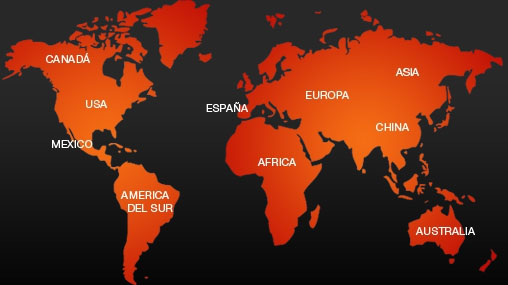- Inicio Acerca de RM Minerales
- Galería de fotos Blog RM Contacto
- Microscopia e instrumentos Pedidos Aviso legal
Copyright 2010-2025
www.rosellminerals.com



Agregados radiales de cristales aciculares de eritrita. Destacan sobre la matriz de goethita.
Un clásico de la mineralogía catalana. Ejemplar formado por agregados de cristales tabulares lanceolados de barita. Incoloros a ligeramente amarillentos. Procede de las Mines d'Osor, actualmente cerradas y de las cuales es imposible obtener estos ejemplares. La mina cerró en 1979 y llegó a tener once plantas con un pozo de 290 metros de profundidad. Aún se pueden ver las ruinas de las antiguas instalaciones y el pozo de donde se extraía y trataba esfalerita, galena y fluorita.
Un clásico de la mineralogía catalana. Ejemplar formado por agregados de cristales tabulares lanceolados de barita. Incoloros a ligeramente amarillentos. Procede de las Mines d'Osor, actualmente cerradas y de las cuales es imposible obtener estos ejemplares. La mina cerró en 1979 y llegó a tener once plantas con un pozo de 290 metros de profundidad. Aún se pueden ver las ruinas de las antiguas instalaciones y el pozo de donde se extraía y trataba esfalerita, galena y fluorita.
Grupo de cristales de epidota de muy buen tamaño e intenso color verde, casi negro. Los cristales muestran muy definidas caras de prismas de diferentes órdenes. Este tipo de cristales son bastante poco habituales para este yacimiento marroquí.
Cristal bien definido de microclina maclado de una localidad muy poco habitual en colecciones. Procede de la colección de Peter Seroka, conocido por su interés en los feldespatos.
Los ejemplares de cerusita de la zona de Mibladen suelen ser amarillentos, en este ejemplar procedente de la colección Seroka podemos ver cristales muy brillantes, transparentes y en macla cíclica los más grandes. No es habitual este tipo de ejemplares en esta zona. Presenta una débil fluorescencia amarilla bajo la luz UV.
Grupo de cristales de turmalina chorlo en crecimiento paralelo, de intenso color negro y con brillo. Con caras terminales definidas. Procede de la colección de Peter Seroka.
Excelente ejemplar de escolecita de una localidad poco vista en colecciones, situada al este de Islandia. Se trata de un agregado radiado de cristales, de intenso color blanco, brillo y buen tamaño. Una curiosidad llegada del frío.
Grupo de cristales escalenoédricos de calcita, transparentes y que permiten ver crecimientos internos (fantasma) de calcita salpiucada de pirita. En la parte posterior numerosos cristales de fluorita violeta y dolomita. De esta clásica localidad asturiana.
Excelente y estético ejemplar formado por un nutrido grupo de cristales de fluorita, muy definidos, con hábito cúbico, aristas biseladas por las caras del dodecaedro. Translúcidos, con zonación de color púrpura. Se disponen sobre una matriz de calcita blanca, sobre la que contrastan. Una pieza para la mejor vitrina.
Agregados botroidales de smithsonita de color verde azulado muy estético, translúcidos y con brillo. Se disponen sobre matriz. De una localidad americana muy interesante. Presenta intensa fluorescencia bajo la luz UV.
Cristales de chabasita-Ca de color naranja intenso y buen brillo, definidos. Con matriz en su parte posterior.
Una pseudomórfisis clásica mexicana. La estibiconita se presenta como un brillante recubrimientosobre cristales prismáticos bien formados de estibina, de muy buen tamaño. Las terminaciones de los cristales están bien definidas, mientras que en la parte posterior del ejemplar son planos por estar en conatcto con la pared de la geoda o cavidad de donde se extrajo la pieza. La estibiconita fue durante mucho tiempo una especie reconocida, pero ahora es cuestionable, de acuerdo con la nomenclatura revisada de los minerales del supergrupo del pirocloro. Estos ejemplares son muy difíciles de ver en el mercado.
Grupo de cristales bipiramidales de wulfenita, muy definidos, brillantes y agudos. Se disponen sobre una matriz tapizada de mottarmita verde oliva. En la parte posterior numerosas cavidades tapizadas de mimetita de color verde con wulfenita. Una pieza muy entretenida y estética. De la colección E. Nicolau con etiqueta manuscrita de J. Viñals.
Diversos cristales de torbernita de pequeño tamaño pero muy definidos. se disponen sobre una matriz de cuarzo cristalizado. Poco habitual para esta localidad portuguesa.
Grupo de cristales de microclina, de buen tamaño, definidos y con brillo, que presentan la macla de Manebach, característica de esta espécie. Con etiqueta de J. Viñals.
Estético ejemplar de goethita con calcofanita con cavidades recubiertas por numerosos agregados de cristales en gavilla de adamita cuprífera, con un color verde ténue en la zona de convergencia y más verdes en los extremos. Se acompaña de cristales más desarrollados de austinita cuprífera. Un placer bajo aumento. Con varias etiquetas.
Drusa formada por numerosos agregados globulares de zanazziita de color marró verdoso que se disponen sobre una matriz pegmatítica con moscovita. La zanazziita es un fosfato hidratado de calcio, magnesio, hierro, aluminio y berilio. Se acompaña de la etiqueta manuscrita.
Cristal de vesuvianita, con caras definidas, biterminado, de color verde a marrón oscuro. Viene etiquetado como procedente la zona de Imilchil. Buen tamaño y estética.
Los ejemplares de allanita-(Ce) de Trimouns son un clásico de la mineralogía francesa. Cabe decir que estso cristales si se analizan composicionalmente, se observa una zonación con la dissakisita-(Ce). Ambas especies pertenecen al grupo de la epidota y se diferencian composicionalmente por la presencia de Fe(II) (allanita) y Mg (la segunda). En este ejemplar podemos observar diversos cristales bien definidos de este mineral, uno de ellos de mayor tamaño, que contrastan con la matriz de dolomita.
Grupo de cristales de piromorfita de color verde a verde pardo, con formas hexagonales muy marcadas y caras y aristas definidas. En matriz. Procede de una mina clásica española y de la que han salido ejemplares de buena calidad como el que ofrecemos. Con etiqueta manuscrita de J. Viñals.
Ejemplar de muy buen tamaño de atacamita formado por numerosos agregados radiales de cristales tabulares, de intenso color verde y transparentes, que se disponen sobre una matriz con crisocola y malaquita. Este ejemplar tiene los dos lados dignos de vitrina. Se acompaña de la etiqueta manuscrita de Joan Viñals.
Excelente ejemplar de fluorapofilita-(K) con cristales de muy buen tamaño que muestran las formas del prisma tetragonal, con caras de la bipirámide truncadas por el pinacoide basal. Muy buena transparencia, brillo y definición. Se dispone de forma muy aérea sobre una matriz con estilbita. Con etiqueta manuscrita de Joan Viñals.
La shungita es una roca, una forma intermedia entre el carbono amorfo y el grafito que contiene carbono (30%), sílice (45%) y micas (alrededor del 20%). La schungita es una roca orgánica formada en los sedimentos precámbricos del fondo marino, con un alto nivel de carbonización y que contiene estructuras regulares tipo fullereno. La shungita obtuvo su nombre del pueblo de Shunga en Karelia (Federación Rusa), ubicado en la orilla del lago Onezhskoe, donde se encuentra el depósito de Zazhoginsky.
La shungita tiene una estructura molecular heterogénea en la que el carbono se presenta como glóbulos de 10 nm distribuidos irregularmente dentro del carbono amorfo. Las propiedades fisicoquímicas y estructurales de la roca se utilizan en diversas aplicaciones industriales y medioambientales, como la metalurgia, la purificación del agua, la termólisis y la organosíntesis de hidrocarburos cíclicos. La shungita es un absorbente eficaz para la eliminación de sustancias orgánicas e inorgánicas, bacterias patógenas y metales pesados del agua contaminada (Ore Geology Reviews, 2004; 24, 1-2:135-154).
Cristal de granate de buen tamaño perteneciente a la serie almandino-spessartina, habitualmente con predominio del primero. Los análisis indican la presencia de Fe y Mn, con trazas de Mg. Estos ejemplares fueron identificados como piropos (aluminosilicato de magnesio), pero los resultados analíticos no lo indican.
